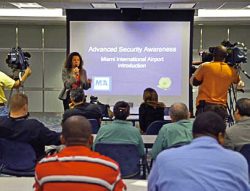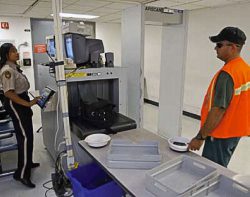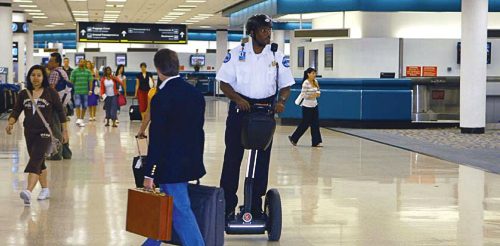|
A fleet of 10 Segways reduces the response time of law enforcement ans security officers covering 4.8 million square feet of space at Miami International. |
|
Lauren Stover |
“Technology comes and goes,” Stover explains. “But the ability to detect anomalies in human behavior will never go obsolete.”
Security specialist Rafi Ron couldn’t agree more. “Terrorists and criminals will always try to find ways to circumvent screening technology,” Ron explains, citing “shoe bomber” Richard Reid and the men who attempted to conceal liquid explosives in a drink bottle as prime examples. “In the Reid case, there were at least five crew members who later told me they had a suspicious feeling about Reid when he boarded the aircraft. The technology that was supposed to have dealt with the threat failed to do so.”
|
Facts & Figures Project: Behavior Pattern Recognition Training Location: Miami International Airport Cost: $80,000 for initial training of police officers Eventual Scope: Entire 33,000 airport workforce Tactical Value: Providing observational skills training to non-security workers increases surveillance throughout airport without incurring equipment costs Other Initiatives: Employee screening before and after shifts; Segway vehicles to reduce response times of security and law enforcement personnel |
Weapons and explosives, Ron stresses, shouldn’t be the only focus of airport security.
“The 9/11 hijackings weren’t about the weapon used,” he continues. “Box cutters weren’t even considered weapons at the time. The 9/11 attacks were about the terrorists who perpetrated the crimes. That’s why it’s so important to screen for suspicious human behavior … for malicious intent.”
Concession and retail employees are key categories of airport workers trained to spot suspicious behavior.
Taking Action

Miami International made the philosophical and tactical switch in 2006, when Ron’s company, New Age Security Solutions, trained 150 airport police to identify potential threats through behavior pattern recognition (BPR). At Stover’s urging, it later committed to training all airport workers in the method.
“Employees such as parking lot attendants, ramp workers, gate agents and food service employees are extremely good at detecting suspicious behavior,” Ron explains. “It’s all about noticing irregularities, and you have to know what’s regular to be able to spot what’s irregular. Who knows a given corner of the airport better than the employees who spend the most time there?”
Several other airports also use BPR, notes Ron, but Miami nternational is the first to deploy the method to its entire employee base.
The results, Stover reports, are well worth the effort: roughly 5,000 calls to local law enforcement and 300 subsequent arrests in just three years. The airport has also referred a few dozen cases to the Federal Bureau of Investigation and about 30 to Immigration and Customs Enforcement – all based on employees’ use of BPR. Overall crime, she reports, is at its lowest level in recorded history at Miami International.
As 2009 ended, more than 29,000 of the airport’s 33,000 workers had already learned to use BPR to flag potential threats. The training is currently a required part of the airport’s badging process and plans are underway to incorporate refresher sessions into the badge renewal process.
“BPR helps employees understand the importance of security and makes it part of their everyday life at the airport,” Stover says. “Part of their contract with us is to be vigilant for suspicious behavior.”
Hour-long sessions offered twice a week in Spanish and English teach workers what to look for. Airport police who provide the training complete a more extensive five-day curriculum.
According to Ron, BPR training goes far beyond reading body language. “Terrorists’ Achilles heal is their behavior,” he explains. “They’re under a tremendous amount of stress, and they unconsciously show it in a variety of ways. In most cases, they’re ‘first timers’ who haven’t had the chance to accumulate practical experience.”
The TSA Way Security specialist Rafi Ron is matter-of-fact about his criticism of the Transportation Security Administration’s strategy for airports: “It’s almost entirely focused on the technology of detecting weapons, and that’s not sufficient. There’s one factor more important to look for and that’s the people attempting to perpetrate the crimes.” Ron consequently applauds TSA’s SPOT Program, short for Screening of Passengers by Observation Techniques. He’d just like to see it used much more often. According to TSA’s official blog in mid-December, SPOT was being used at 161 airports nationwide. SPOT uses behavior observation and analysis to identify “high-risk” passengers – techniques similar to those used in a method Ron developed, but assembled into TSA’s own program. SPOT training for behavior detection officers (BDOs) includes four days of classroom instruction and 24 hours of on-the-job training at an airport security checkpoint. One of the skills BDOs learn is how to read the fleeting involuntary physical and physiological reactions people exhibit when they fear being discovered. Paul Ekman, a psychologist who developed some of the training methods, addressed the role of “micro-expressions” during a PBS NewsHour interview. “They last typically a twenty-fifth-of-a-second,” Ekman explained. “Most often, they’re fairly intense. But they’re so fast that, without training, you don’t see them.” TSA credits the SPOT program with many successes since its inception in 2003 – including the identification of a passenger carrying surveillance photos of high-risk buildings and bridges. In a separate instance, a BDO used skills learned in SPOT training to pinpoint an individual at a ticket counter who was carrying a loaded gun and more than 30 rounds of ammunition. At Boston Logan, a BDO observed several passengers making clandestine signs to one another, while pretending not to know each other. They later admitted to being paid $5,000 to travel between airports and observe security. Behavioral clues also helped a Logan BDO pinpoint a passenger who turned out to be carrying illegal amounts of prescription medication, more than $20,000 in cash and another person’s passport. A BDO in Minneapolis-St. Paul International used SPOT skills to flag an individual who was carrying prohibited items in his accessible baggage. Subsequent investigation revealed he had previously been deported to Mexico after being charged with a double murder. “The exact behaviors this individual exhibited are identical to what we could see from a terrorist before an attack,” said Mo McGowan, assistant administrator of Security Operations. “This is a great example of why the behavior observation program is so crucial to TSA’s multi-layered approach to security.” The unpredictable nature of who is referred for further screening and when and where further investigation will occur is considered a major strategic advantage of SPOT.
Trickle-Down Value
Although the $80,000 expense to train airport police was incurred shortly before her tenure at the airport began, Stover considers it money well spent. By having police train the rest of the airport staff, she multiplied its cost-effectiveness – effectively squeezing new value from existing workforce assets. BPR training also allows security costs to be absorbed into regular hourly wages.
Stover credits aviation department director José Abreu and Rubin Galindo, police major at the time, for supporting the ambitious training initiative.
“At many airports, management doesn’t want to risk going beyond compliance requirements,” notes Ron. “That’s ironic, because the ultimate risk is a terrorist action. They should do as much as possible to mitigate that risk, not the minimum requirement. Miami had the full support of management, and that’s very important.”
The economics of the initiative likely helped.
“BPR is cheap,” Stover says bluntly. “These are hard economic times for all airports. Training employees to look for suspicious behavior offers a way to increase security without investing in costly equipment.”
Power of the Press
Initially, BPR training at Miami International was a voluntary program. Stover consequently launched the first session just before the fifth anniversary of the 9/11 attacks to help garner interest. A background in media relations at the Transportation Security Administration (TSA) and Department of Homeland Security prompted Stover to invite news reporters to cover the first training session of approximately 80 janitors.
The strategy resulted in positive coverage from Good Morning America, The MacNeil/Lehrer NewsHour, NBC Nightly News, CNN, USA Today and many others.
“It was an unorthodox approach,” Stover recalls. “Many airports see the media as a potential interruption to security efforts, but we see them as our ally. Through the press, we can extend our communication beyond the perimeter of the airport and into the living rooms of the general public. We can send the clear message that Miami International is not the place for people with ill intentions.”
Media access was not unlimited. Portions of the training that could potentially prove helpful in circumventing security measures were closed to reporters. Balancing the public’s “right to know” with
security strategy is familiar territory for Stover. She drew on her
experience with communication post-9/11 TSA policies to the media and managing national press coverage of Hurricane Katrina.
 |  |
Employees at Miami International are screened before and after their shifts. Reducing employee access to eight guarded entry points further tightened security.
Execution is Everything
Miami International’s broad-based BPR training is largely an issue of sheer physical coverage. Law enforcement and security personnel simply can’t be everywhere at all times in a terminal that measures more than a mile from end to end and includes 4.8 million square feet of total space. Next year, their jurisdiction will nearly double in size with the completion of the airport’s new North Terminal.
BPR by non-security employees adds to the airport’s already multi-layered surveillance. Janitors, Ron notes, can be especially effective in areas such as rest rooms, where criminals or terrorists may let down their guard due to the lack of security cameras. Importantly, he adds, they can observe activity without invading people’s privacy.
Ensuring employees follow proper protocol using BPR is crucial, but the manner in which security forces follow up on suspicions is equally important, Ron stresses.
“Airports can get tremendous public support in security efforts by training employees to follow clear methodology that uses a positive approach vs. a more traditionally aggressive law enforcement approach,” he explains.
A quick, efficient manner with a friendly demeanor is crucial, he emphasizes. “There are plenty of legitimate reasons why people in airports show signs of stress,” he specifies.
The challenge is sorting out those who are behaving suspiciously because of criminal intentions while not inconveniencing or offending other airport visitors.
About two years ago, BPR received a coveted but qualified nod from the American Civil Liberties Union in a segment shown on NBC Nightly News. ACLU’s Howard Simon noted that unlike profiling, BPR doesn’t violate civil rights. Simon also, however, expressed concern about the amount of training airport employees receive and the risk of them reverting to “preconceived notions of what a terrorist looks like.”
“Without the proper training, BPR can simply be a fig leaf to cover prejudice and racial profiling,” cautions Ron.
In December, mandatory hour-long customer service training for all employees at Miami International was initiated by the Miami-Dade Aviation Department. The Greater Miami Convention and Visitors Bureau, the Miami Beach Convention and Visitors Authority and Miami-Dade College are partners in the effort.
Legal Implications
Ron and Stover stress the difference between BPR and profiling. BPR, they specify, focuses on human behavior rather than racial characteristics.
“Profiling is morally, legally and professionally bad,” says Ron, noting that it allows locally bred terrorists such as John Walker to slip through the system.
Although BPR was developed based on Ron’s experience as director of Security at Ben Gurion International Airport in Tel Aviv, the American judicial system guided its development.
“Airports have to be careful about what is allowed and not allowed according to the First and Fourth Amendments,” he notes. “BPR takes that into account. It’s a fully American and politically correct program.”
Ron endured plenty of legal scrutiny when he originally developed BPR as part of a comprehensive security overhaul for the Massachusetts Port Authority after the 9/11 attacks. “At the first session, we had 18 trainees and 24 lawyers,” he laughs.
At Miami International, airport authorities met with the Community Relations Board regarding initial concerns over potential profiling. After participating in the training, the board concluded BPR did not include racial profiling.
The “Inside Threat”
Stover cites 100% employee screening as another industry-wide first that bolsters security at Miami International. “We screen all employees accessing the secured areas before and after their shifts with the same technology used at passenger checkpoints,” she says.
Private screeners can electronically transmit images of questionable items to Michael Stapleton & Associates in New York for review by former bomb explosive specialists from the New York Police Department. “Within seconds, they advise screeners whether to call the police or how best to proceed,” says Stover.
Employees’ laptops and other electronic devices are also screened the same way passengers’ are.
Equipment for employee screening originally cost about $2.5 million, reports Stover. Employee screeners add another $1.2 million per year. Overall, the airport spends about $5 million annually on private guards, she notes. Software and image review services from Stapleton cost $22,000 per year.
“The federal government doesn’t require employee screening, but we think it’s the thing to do,” Stover explains. “It helps keep employees honest knowing that they’ll be checked on the way in and out.”
Throughout the years, screeners have intercepted firearms, drugs and stolen property from airport employees, but nothing potentially explosive, she reports.
Miami International also uses undercover police and other less visible measures to mitigate the chances of employees bypassing checkpoints or mounting other illegal activities. “The ‘inside threat’ is definitely a concern,” Stover says gravely. “We know there are people who will do anything for a bribe, so we have to be on our game every minute.”
Reducing employee access points from 600 to eight over the last nine years has been a tremendous help, she adds.




